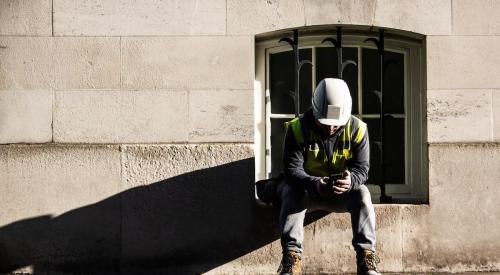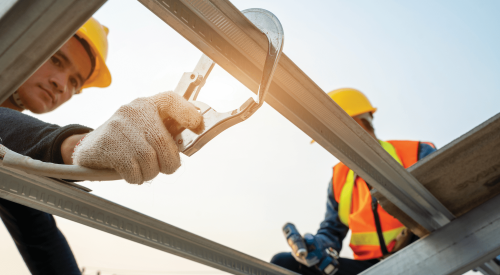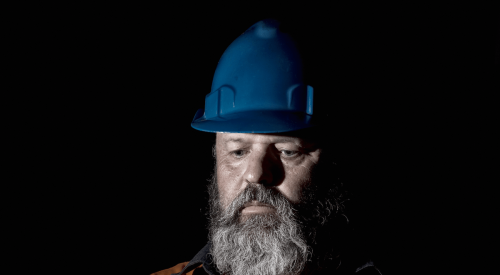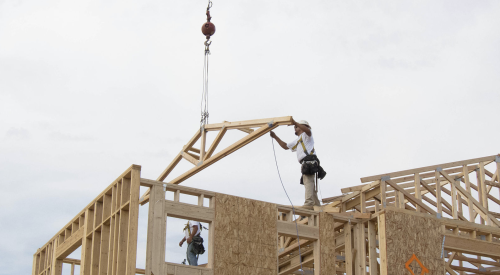In 2016, the suicide rate for construction and related occupations was nearly twice the rate for all civilian male workers. Given this statistic, a comprehensive jobsite safety plan for home building companies should also include tools and resources to recognize, alleviate, and destigmatize emotional hazards and stress that can lead to feelings of desperation and hopelessness. Scroll down to read about the policies and actions being taken by builders and industry groups, and find out more about jobsite safety best practices in our article, Construction Jobsite Safety: Strategies and Resources for Worker Well-Being.
Construction Industry Suicide Rate Higher Than Most
A study by the Centers for Disease Control and Prevention found that the suicide rate for construction and extraction occupations, at 49.4 per 100,000 persons, in 2016 was nearly twice the rate for all civilian working men in 32 states, and five times greater than the rate in 2018 for all causes of construction-related fatalities.
Those data points set off alarms that have moved mental health more urgently into the conversation about construction jobsite safety.
RELATED
- NAHB Chairman's Letter: Mental Health and Worker Well-Being
- Samantha Lewandowski on Recovery-Friendly Workplaces
- Construction Site Fall Protection Made Simple
What's Being Done to Address Mental Health and Construction's High Suicide Rate
- The National Association of Home Builders (NAHB) has created a dedicated page on its website that emphasizes builder support for healthy work environments. David Jaffe, NAHB's VP of legal advocacy, says the site includes an online test that members can take to gauge their wellbeing. The association's goal is to to change the culture in the construction industry around mental health awareness and provide resources tailored to construction workers, managers, developers, and business owners in the industry.
- In May, three organizations—the Construction Industry Alliance for Suicide Prevention, United Suicide Survivors International, and the Johnson Depression Center at the University of Colorado—hosted the inaugural Construction Working Minds Summit in Denver, which drew 200 attendees. The stated purpose of the summit was to initiate discussions about possible solutions to mental health challenges. The event revealed that an estimated 5,000 construction workers kill themselves each year, and the triggers include physical trauma, chronic pain, deadlines and long hours, and fear of unemployment.
- In March, Associated Builders and Contractors and the American Foundation for Suicide Prevention joined forces to develop strategies for education, suicide prevention, intervention, and postvention (which is defined as the organized immediate, short-term, and long-term response in the aftermath of a suicide to promote healing and mitigate negative effects of exposure to suicide).
- Working with NAHB and the Job-Site Safety Institute, the North Carolina HBA (NCHBA) has developed a Blueprint for Worker Wellbeing, a pilot program that the national organization plans to roll out in fall of 2022. The purpose of this program, says Jeff Turner, a spokesman for the NCHBA, is to cultivate mental health advocates within home building companies.
The Best Approach for Engaging Construction Workers in Addressing Mental Health
This goal is daunting because mental health is not something workers in the construction industry are disposed to talk about. As part of NCHBA's pilot, the organization sent questionnaires to its 14,000 members; just 200 completed questionnaires were returned, Turner says. This stoicism and tough-mindedness may also contribute to the stress that affects contractors’ mental health, says Dr. Sally Spencer-Thomas, president of United Suicide Survivors International, who is consulting on the pilot program.
Spencer-Thomas believes the best approach to get builders and contractors to open up about their mental health and challenges is through “storytelling” by their peers. (This summer, her organization will conduct a virtual storytelling retreat, with three 2-hour sessions.) Through NCHBA’s survey, four storytelling champions emerged, and their stories are being showcased in workshops, videos, and other communication platforms. One of these is Brandon Bryant, owner of Red Tree Builders, in Asheville, N.C.
Bryant’s story is tragic: His grandmother and mother-in-law both passed away within just two weeks of each other. Then COVID-19 started spreading, and he was infected with the virus around Christmas of 2020. “I wasn’t in a good place, mentally,” Bryant recalls. COVID protocols only heightened his anxiety. But talking about his experience has been therapeutic for Bryant. It was this series of events, he says, that made him realize the construction industry’s safety programs really need to include a mental health component.
Indeed, Boulder Creek Neighborhoods, a safety-minded builder in Colorado, recently launched an initiative called I-SEE-U, to encourage more conversation within the company about mental health because “you don’t always have visible clues,” says Kyle Ellis, the builder’s director of construction.
Find out more about construction jobsite safety education and training in Pro Builder's article, Construction Jobsite Safety: Strategies and Resources for Worker Well-Being.













